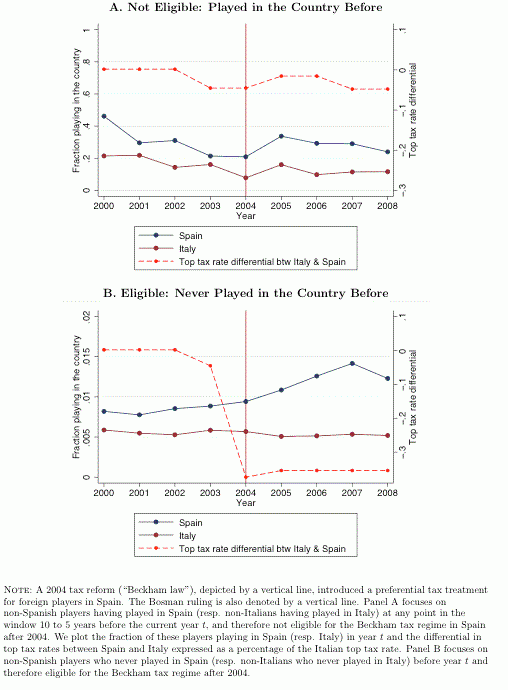This month news stories are coming thick and fast of footballers moving clubs during the European transfer window. The latest gossip suggests that David Beckham could be making an emotional return to English football. Could this movement of supposedly highly skilled and certainly highly paid individuals tell us something about the influence of taxes on international labour mobility?
Tax-induced international mobility of talent is a crucial public policy issue, especially when tax rates differ substantially across countries and migration barriers are low, as in the case of the EU. In this case, high tax rates on high-paid workers may induce such workers to migrate to countries where the tax burden is lower. Therefore, international mobility may severely limit the ability of governments to redistribute income through highly progressive taxation. Moreover, concerns have been raised that the mobility of skilled workers is generating harmful tax competition driving down the progressivity of taxation in European countries. As a result, the mobility response to high tax rates perhaps looms even larger in the policy debate on optimal tax progressivity than traditional within-country labour supply responses.
While an enormous empirical literature has studied standard labour supply responses to taxation, there is very little empirical work on the effect of taxation on the geographical mobility of people, especially among high-skilled workers. A small literature has considered the mobility of people across local jurisdictions within countries (e.g. Kirchgassner and Pommerehne 1996 on Swiss Cantons; Feldstein and Wrobel 1998 on American States), but empirical work on the effect of taxation on international mobility appears to be virtually non-existent. The reason for this is a lack of micro data containing citizenship information along with issues about how to identify causal effects on migration. In a recent paper (Kleven et al. 2010), we take a first step to fill this gap in the literature by focusing on a specific labour market, the market for professional football players in Europe.
International mobility among football players has recently been the subject of heated discussion in the UK in connection with the increase in the top marginal tax rate from 40% to 50%. Supposedly, the star player Cristiano Ronaldo moved from Manchester United to Real Madrid in 2009 partly to avoid the announced 50% tax in the UK and instead benefit from the so-called “Beckham Law” in Spain, a preferential tax scheme offering a flat tax of 24% to foreign residents. (The nickname for this tax scheme was coined a few years earlier when another star player, David Beckham, also moved from Manchester United to Real Madrid to benefit from the scheme.) Arsene Wenger, the emblematic manager of Arsenal FC, commented on the UK tax reform by saying that “with the new taxation system, (...), the domination of the Premier League will go, that is for sure” (The Sunday Times, 25 April, 2009).
The football market offers three important advantages for the study of mobility.
- First, international mobility has been very common in the professional football market ever since the Bosman ruling by the European Court of Justice in 1995 lifted pre-existing restrictions on player mobility. In the absence of such restrictions, cross-border mobility is higher in the football market than in most other markets owing to the fact that the game is the same everywhere and involves very little country-specific human capital. This makes the football market a valuable laboratory to begin the study of tax-induced mobility across countries. In particular, football players may provide an upper bound on the migration response to taxation for the labour market as a whole. Obtaining an upper bound is crucial to gauge the potential importance of this policy question, especially in the long run as labour markets become more international and country-specific human capital declines in importance.
- Second, extensive data on the careers and mobility of professional football players can be gathered for most countries over long time periods. For this project, we have gathered exhaustive data on the career paths of all first-league football players for 14 EU countries over the past 30 years, as well as performance data for all first-league teams.
- Third, and most importantly, there are many sources of variation in tax policy which can be exploited to identify the causal effect of taxation on mobility in the football market. In particular, a number of countries have experimented with special tax schemes offering substantially lower tax rates to immigrant football players, including Denmark (1991), Belgium (2002) and Spain (2004). An analysis of these tax schemes produces convincing evidence that international mobility patterns do indeed respond to taxation. For example, when Spain introduced the Beckham Law in 2004, the fraction of foreigners in the Spanish league immediately and sharply started to diverge from the fraction of foreigners in the comparable Italian league. Moreover, exploiting the specific eligibility rules in the Beckham Law, we show that the extra influx of foreigners in Spain is driven entirely by players eligible for the scheme with no effect on ineligible players (see Figure 1 below).
Figure 1. Effects of the Spanish Beckham Law on the probability of playing in Spain by eligibility status.
Combining the evidence from tax reforms in all 14 countries in our sample, we find that the location decisions of players are very responsive to tax rates. But because labour demand by football clubs is relatively rigid—there can only be so many players in a club and only so many clubs in each National league –- we also find strong evidence of sorting effects. Top-quality players are much more responsive than lower-quality players. In fact, we find that tax cuts to foreigners in a given country attracts top-quality foreign players, but ends up crowding out lower-quality foreign players as well as displacing some domestic players.
How and why do these results matter for public policy? First, they matter for the football labour market. Here, our results clearly call for a reappraisal of the effectiveness of preferential tax schemes to highly paid foreigners. Implementing a favourable tax treatment of foreigners is able to attract top-quality players, which brings in new tax revenue and increases the quality of the League. However, because of sorting effects, part of this new revenue is lost as domestic players are displaced. This implies that preferential tax schemes to foreign players ultimately have limited power to raise revenue in a rigid labour market setting such as the football market. Moreover, these schemes create negative externalities on other countries as they lose their top players, highlighting the need for tax coordination among European countries. In the absence of coordination, as many more countries enact preferential tax treatments, the positive effects of having low tax rates tend to disappear in a pure race to the bottom, detrimental to all.
Second, our results matter for policies much more broadly in the sense that they demonstrate for the first time a clear effect of taxation on international migration and sorting of high-skilled labour. Since football players are likely to be a particularly mobile segment of the labour market, it is of obvious interest to broaden the analysis to other high-income workers. This will be an important topic for future research.
References
Feldstein, M and MV Wrobel (1998), “Can state taxes redistribute income?”, Journal of Public Economics, 68:369-396.
Kirchgassner, G, and WW Pommerehne (1996), “Tax harmonization and tax competition in the European Union: Lessons from Switzerland”, Journal of Public Economics, 60:351-371.
Kleven, Henrik, Camille Landais, and Emmanuel Saez (2010), “Taxation and International Migration of Superstars: Evidence from the European Football Market”, NBER Working Paper 16545, November.






